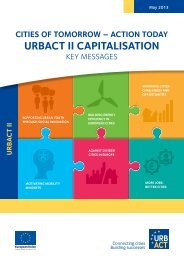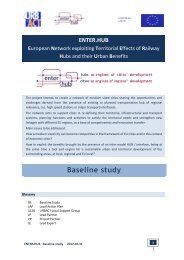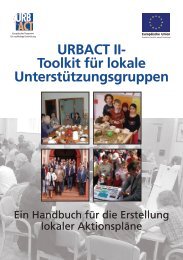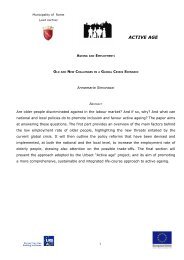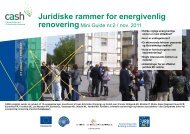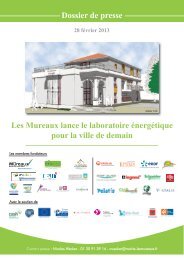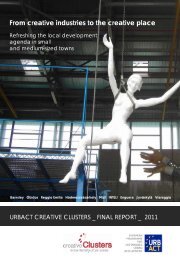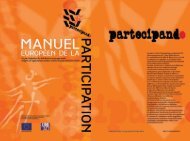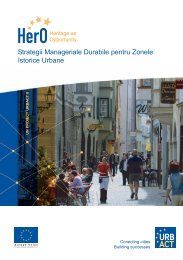The Local Action Plan (LAP) 2010-2020 of Frankfurt (Oder ... - Urbact
The Local Action Plan (LAP) 2010-2020 of Frankfurt (Oder ... - Urbact
The Local Action Plan (LAP) 2010-2020 of Frankfurt (Oder ... - Urbact
Create successful ePaper yourself
Turn your PDF publications into a flip-book with our unique Google optimized e-Paper software.
<strong>The</strong> <strong>Local</strong> <strong>Action</strong> <strong>Plan</strong> (<strong>LAP</strong>) <strong>2010</strong>-<strong>2020</strong> <strong>of</strong><br />
<strong>Frankfurt</strong> (<strong>Oder</strong>) & Słubice conurbation<br />
on the improvement <strong>of</strong> Cross Border Governance<br />
1 st <strong>of</strong> April <strong>2010</strong>
<strong>The</strong> <strong>Local</strong> <strong>Action</strong> <strong>Plan</strong> <strong>2010</strong>-<strong>2020</strong> <strong>of</strong> <strong>Frankfurt</strong> (<strong>Oder</strong>) & Slubice conurbation<br />
TABLE OF CONTENTS<br />
Introduction 3<br />
1. URBACT <strong>Local</strong> Support Group (ULSG) and cross border governance structures 6<br />
2. Leadership 9<br />
3. Civil society involvement 11<br />
4. Vision, goals and planned activities in <strong>Frankfurt</strong>-Słubice <strong>Action</strong> <strong>Plan</strong> <strong>2010</strong>-<strong>2020</strong> 13<br />
5. Communication 16<br />
Conclusion 17<br />
Appendix 1: Cross border governance working structures 18<br />
Appendix 2: SWOT analysis – version in German language 19<br />
2
<strong>The</strong> <strong>Local</strong> <strong>Action</strong> <strong>Plan</strong> <strong>2010</strong>-<strong>2020</strong> <strong>of</strong> <strong>Frankfurt</strong> (<strong>Oder</strong>) & Slubice conurbation<br />
<strong>The</strong> <strong>Local</strong> <strong>Action</strong> <strong>Plan</strong> (<strong>LAP</strong>) <strong>2010</strong>-<strong>2020</strong> <strong>of</strong><br />
<strong>Frankfurt</strong> (<strong>Oder</strong>) & Słubice conurbation<br />
on the improvement <strong>of</strong> Cross Border Governance<br />
INTRODUCTION<br />
<strong>The</strong> “EGTC” URBACT project (Expertising Governance for Transfrontier<br />
Conurbations) is a European working group co-financed by the URBACT II<br />
programme (2007-2013). This programme aims to encourage the sharing <strong>of</strong> experiences<br />
between European cities and to disseminate knowledge on sustainable urban development<br />
throughout Europe.<br />
<strong>The</strong> project is led by Mission Opérationnelle Transfrontalière (MOT); it involves six cross-<br />
border conurbations in Europe: Lille Metropole for the Eurometropole Lille-Kortrijk-Tournai<br />
(F/BE), Basel for the Trinational Eurodistrict Basel (F/DE/CH), Esztergom for the Ister-<br />
Granum EGTC (HU/SK), Chaves for the conurbation Chaves-Verin (ES/PT), Slubice for the<br />
<strong>Frankfurt</strong> (<strong>Oder</strong>)-Slubice conurbation (DE/PL), and Strasbourg for the Eurodistrict<br />
Strasbourg-Ortenau (F/DE).<br />
3
<strong>The</strong> partners aimed to:<br />
<strong>The</strong> <strong>Local</strong> <strong>Action</strong> <strong>Plan</strong> <strong>2010</strong>-<strong>2020</strong> <strong>of</strong> <strong>Frankfurt</strong> (<strong>Oder</strong>) & Slubice conurbation<br />
- improve their governance models by exchanging experiences, with the support<br />
<strong>of</strong> the Lead Expert,<br />
- capitalize best practices, spread models <strong>of</strong> governance throughout Europe and,<br />
- promote cross-border agglomerations at national and European levels.<br />
<strong>The</strong> new opportunities provided by the European Grouping <strong>of</strong> Territorial Cooperation, the<br />
European instrument (EC Regulation 1082/2006), whose use is still under experimentation,<br />
constituted an interesting case study. <strong>The</strong> first two European Groupings <strong>of</strong> Territorial<br />
Cooperation in Europe were involved in the “EGTC” URBACT project and an EGTC was<br />
established during the project.<br />
By “cross-border governance”, the project partners have agreed to deal with the<br />
following two major themes:<br />
- How can public leaders and cross-border organizations frame and implement efficient<br />
policies (“Leadership” issues)?<br />
4
<strong>The</strong> <strong>Local</strong> <strong>Action</strong> <strong>Plan</strong> <strong>2010</strong>-<strong>2020</strong> <strong>of</strong> <strong>Frankfurt</strong> (<strong>Oder</strong>) & Slubice conurbation<br />
<strong>The</strong> way a cross-border conurbation is managed on a technical, political, legal, as well as<br />
financial point <strong>of</strong> view. <strong>The</strong> main question resulting from this issue is the one <strong>of</strong> designing<br />
and implementing cross-border urban strategies and concrete projects by involving all<br />
relevant public stakeholders on both sides <strong>of</strong> border.<br />
- How can the involvement <strong>of</strong> the civil society guarantee the legitimacy <strong>of</strong> cross-border<br />
agglomeration policies (“Community” issues)?<br />
<strong>The</strong> way a cross-border conurbation earns its legitimacy to intervene above national<br />
borders, through the development <strong>of</strong> mobilizing projects aimed at citizens, through the<br />
development <strong>of</strong> services dedicated to the citizens, through the emergence <strong>of</strong> cross-border<br />
Medias which enable a dialogue with the inhabitants, and through the creation <strong>of</strong><br />
participative democracy mechanisms. <strong>The</strong> main question related to this issue is the one <strong>of</strong><br />
building efficient and legitimate partnerships able to address cross-border territorial cohesion<br />
issues.<br />
In order to make sure that the URBACT projects lead to concrete and realistic outcomes, the<br />
URBACT II programme requires specific results from the URBACT project partners:<br />
• Each partner realizes a <strong>Local</strong> <strong>Action</strong> <strong>Plan</strong>, which identifies the measures and<br />
actions which will be implemented in order to improve the running policies. It aims to<br />
provide pragmatic, precise solutions based on the results <strong>of</strong> the transnational<br />
exchanges. It is jointly produced with the <strong>Local</strong> Support Group (link) on the local level<br />
and with all the project partners on a transnational level.<br />
• All URBACT project partners commit to establishing and leading an URBACT <strong>Local</strong><br />
Support Group to make sure that exchanges have an impact on local practices and<br />
policies. This group assembles the main interested parties and local actors concerned<br />
by the project topic and the issues the partner is looking to resolve; the groups<br />
include local elected <strong>of</strong>ficials, representatives <strong>of</strong> various local administrative<br />
departments, representatives <strong>of</strong> residents/users, etc.<br />
URBACT <strong>Local</strong> Support Groups contribute to implementing transnational activities<br />
(production/approval <strong>of</strong> case studies, for example) and producing the <strong>Local</strong> <strong>Action</strong><br />
<strong>Plan</strong> that each partner has to produce as the result <strong>of</strong> participation in the URBACT II<br />
programme.<br />
For more information: http://urbact.eu<br />
5
<strong>The</strong> <strong>Local</strong> <strong>Action</strong> <strong>Plan</strong> <strong>2010</strong>-<strong>2020</strong> <strong>of</strong> <strong>Frankfurt</strong> (<strong>Oder</strong>) & Slubice conurbation<br />
1. ULSG AND CROSS BORDER GOVERNANCE STRUCTURES<br />
<strong>The</strong> history <strong>of</strong> cross border cooperation between <strong>Frankfurt</strong> (<strong>Oder</strong>) and Słubice begins after<br />
1945, because before World War II Słubice was called Dammvorstadt and was just a part <strong>of</strong><br />
the German city <strong>of</strong> <strong>Frankfurt</strong> (<strong>Oder</strong>).<br />
Between 1945 and 1990 cross border cooperation existed on different levels: there were<br />
cultural exchanges and contacts on the political level. Some hundred Polish citizens<br />
permanently worked in the microchip factory in <strong>Frankfurt</strong>. Nonetheless, in that period<br />
cooperation could not have been called cross border governance.<br />
After 1990 the cooperation between both municipalities within two free democratic countries<br />
became more intensive and partnership alike. Elements <strong>of</strong> cross border governance<br />
appeared in 2003 as the membership <strong>of</strong> Poland in the European Union came in sight,<br />
when both cities established a programme <strong>of</strong> joint city planning called “European<br />
Garden 2003”.<br />
<strong>The</strong> abolishment <strong>of</strong> border controls at the end <strong>of</strong> 2007 facilitated normal cross border<br />
contacts. At the beginning <strong>of</strong> 2008, <strong>Frankfurt</strong> (<strong>Oder</strong>) and Słubice, together with a population<br />
<strong>of</strong> approximately 80.000 inhabitants, joined the URBACT EGTC project …<br />
<strong>The</strong> <strong>Local</strong> <strong>Action</strong> <strong>Plan</strong> <strong>2010</strong>-<strong>2020</strong> consists <strong>of</strong> five sectors <strong>of</strong> activity:<br />
1. URBACT <strong>Local</strong> Support Group (ULSG) and cross border governance structures<br />
2. Leadership<br />
3. Civil society involvement<br />
4. Vision, goals and planned activities in <strong>Frankfurt</strong>-Słubice <strong>Action</strong> <strong>Plan</strong> <strong>2010</strong>-<strong>2020</strong><br />
5. Communication<br />
Each <strong>of</strong> these sectors consists <strong>of</strong> four steps:<br />
A) Situation before joining the URBACT-EGTC project<br />
B) Achievements during the project (2008-<strong>2010</strong>)<br />
C) Challenges and objectives for the next years<br />
D) Recommendations<br />
A) Situation before joining the URBACT-EGTC project<br />
Before 2008, work meetings existed between both Mayors as well as the Joint City Council<br />
Committee, consisting <strong>of</strong> City Council Members <strong>of</strong> both City Councils. <strong>The</strong> Joint City Council<br />
Committee met only once or twice a year. Joint City Council Meetings took place from time<br />
to time, almost always being concerned with declarations rather than with decisions on<br />
6
<strong>The</strong> <strong>Local</strong> <strong>Action</strong> <strong>Plan</strong> <strong>2010</strong>-<strong>2020</strong> <strong>of</strong> <strong>Frankfurt</strong> (<strong>Oder</strong>) & Slubice conurbation<br />
common projects. Work meetings at administration level were organized mainly when one<br />
partner addressed an urgent need to the other.<br />
B) Achievements during the project (2008-<strong>2010</strong>)<br />
Best practises from Eurométropole Lille-Kortrijk-Tournai and Eurodistrict Strasbourg-Ortenau<br />
showed us that although we do not have any common legal structure, we do have to<br />
improve our cross border governance structures in order to become more efficient.<br />
Cross border governance structures were elaborated: on different levels work<br />
meetings were held more <strong>of</strong>ten and more regularly. By working out the <strong>Local</strong> <strong>Action</strong> <strong>Plan</strong>,<br />
cross border work became more relevant, more concrete and better planned.<br />
Since 2009 our cross border governance structures (see also appendix 1), which we<br />
called ULSG or better <strong>Local</strong> Support System, are as follows:<br />
Leading level - „Executive“<br />
Lord Mayor (LM) <strong>of</strong> <strong>Frankfurt</strong> (<strong>Oder</strong>) and Mayor (M) <strong>of</strong> Słubice<br />
Function: According goals and strategies, coordination <strong>of</strong> administrative actions<br />
Frequency: 1x/ month<br />
Leader team (LM/M and councillors)<br />
Function: see above<br />
Frequency: 6x/ year<br />
Steering Group (LM/M, Heads <strong>of</strong> department)<br />
Function: see above<br />
Frequency: 6x/ year<br />
Leading level - „Legislative“<br />
Joint City Council Meeting (JCCM)<br />
Function: confirmation <strong>of</strong> goals and strategies, control <strong>of</strong> their realization<br />
Frequency: 1x/ year<br />
Joint City Council Committee (JCCC)<br />
Function: Initialization <strong>of</strong> resolutions/decisions and their discussion<br />
Frequency: 4-6x/ year<br />
Implementation level<br />
Working groups (WG): Economic development, city planning, education and culture, city<br />
marketing, international cooperation<br />
Function: realization <strong>of</strong> goals, implementation <strong>of</strong> projects<br />
Frequency: 1x/ month<br />
7
<strong>The</strong> <strong>Local</strong> <strong>Action</strong> <strong>Plan</strong> <strong>2010</strong>-<strong>2020</strong> <strong>of</strong> <strong>Frankfurt</strong> (<strong>Oder</strong>) & Slubice conurbation<br />
Coordination team<br />
Function: project development and management, reporting, PR, civil society dialogue,<br />
organization <strong>of</strong> meetings/workshops, mediation, services (translation, presentation)<br />
Civil society<br />
Citizens’ Conference and participation <strong>of</strong> citizens in the WG’s;<br />
Function: creating new ideas, joint realization <strong>of</strong> measures, public control<br />
Frequency: 1x/ year<br />
<strong>The</strong> <strong>Frankfurt</strong>-Słubice <strong>Action</strong> <strong>Plan</strong> <strong>2010</strong>-<strong>2020</strong> has been worked out on numerous workshop<br />
meetings after the Future Conference (see p. 9). Drafting was organized by the<br />
Coordination Team, which consisted <strong>of</strong> one Polish and one German administration<br />
employee, and one common external expert. A cross border political agreement about<br />
the content was found during two Steering Group Meetings on13 October and 8 December<br />
2009.<br />
A significant empowerment <strong>of</strong> the cross border working structures will be given by the<br />
<strong>Frankfurt</strong>-Słubice Cooperation and Communication Centre, which will start to work in<br />
summer <strong>2010</strong> with four employees (two German and two Polish). Responsible to both<br />
administrations, they will be concerned only with cross border issues, mainly with the task <strong>of</strong><br />
a sustainable implementation <strong>of</strong> our <strong>Action</strong> <strong>Plan</strong>. <strong>The</strong> project is financed for three years by<br />
Interreg IVA funding and by investing the administrations’ personal costs as own<br />
contribution.<br />
C) Challenges and objectives for the next years<br />
<strong>Frankfurt</strong> and Słubice ought to maintain and develop further their cross border governance<br />
structures. On the one hand that means the need to establish regular and project-<br />
independent funding <strong>of</strong> cross border governance. Beside the URBACT-EGTC project, cross<br />
border cooperation between <strong>Frankfurt</strong> and Słubice in the years 2008-<strong>2010</strong> was financed by<br />
two different INTERREG projects: by the Foundation <strong>of</strong> German-Polish Cooperation and by<br />
EU Citizenship Programme. Money was spent mainly on external expert fees for cross border<br />
coordination and on organizational costs for conferences, workshops and meetings on the<br />
different levels <strong>of</strong> cross border governance.<br />
On the other hand it intends to decide until the end <strong>of</strong> <strong>2010</strong>, whether building an<br />
EGTC (European Grouping <strong>of</strong> Territorial Cooperation) might be useful or not.<br />
Project partner Istergranum EGTC gave a good example <strong>of</strong> how to finance cross border<br />
governance in a sustainable way, as they decided to spend automatically 1% <strong>of</strong> annual trade<br />
tax incomes in their EGTC.<br />
8
<strong>The</strong> <strong>Local</strong> <strong>Action</strong> <strong>Plan</strong> <strong>2010</strong>-<strong>2020</strong> <strong>of</strong> <strong>Frankfurt</strong> (<strong>Oder</strong>) & Slubice conurbation<br />
Linked to the question <strong>of</strong> building an EGTC it is also the matter <strong>of</strong> involving regional<br />
levels such as the Euroregion Viadrina, the neighbouring counties Märkisch-<strong>Oder</strong>land, <strong>Oder</strong>-<br />
Spree and County <strong>of</strong> Słubice, the State <strong>of</strong> Brandenburg and Voivodship <strong>of</strong> Lubuskie and the<br />
national level such as the Federal Ministry <strong>of</strong> Foreign Affairs and the Polish Ministry <strong>of</strong><br />
Regional Development into the cross border governance structures. With regard to <strong>Frankfurt</strong><br />
and Słubice, they may learn from the know-how <strong>of</strong> project partners like Eurométropole Lille-<br />
Kortrijk-Tournai and Eurodistrict Strasbourg-Ortenau. <strong>The</strong> objective ought to be that the<br />
specificity and the interests <strong>of</strong> cross border territories like <strong>Frankfurt</strong>-Słubice find an<br />
implementation on regional and national levels.<br />
D) Recommendations<br />
“Establish a direct management <strong>of</strong> structural funds by EGTC’s covering cross border<br />
territories, which have a cross-border integrated strategy.” (see URBACT-EGTC booklet)<br />
2. LEADERSHIP<br />
A) Situation before joining the URBACT-EGTC project<br />
Cross border leadership had to face a serious defeat when in 2006 <strong>Frankfurt</strong>’s City Council,<br />
after two years <strong>of</strong> expertise, resigned to its own former positive resolution concerning the<br />
construction <strong>of</strong> a tramway track over the city bridge to Słubice, in reaction to the negative<br />
result <strong>of</strong> a citizens’ survey.<br />
B) Achievements during the project (2008-<strong>2010</strong>)<br />
<strong>The</strong> leading roles on cross border issues <strong>of</strong> the Lord Mayor <strong>of</strong> <strong>Frankfurt</strong> and the Mayor <strong>of</strong><br />
Słubice were strengthened during the project, as at the head <strong>of</strong> the ULSG, the <strong>Frankfurt</strong>-<br />
Słubice Steering Group was settled. <strong>The</strong> Steering Group first met in August 2008,<br />
consisting <strong>of</strong> both Mayors and Heads <strong>of</strong> administration departments <strong>of</strong> Economic<br />
Development, City Marketing, City <strong>Plan</strong>ning, Culture and Education, and Cross Border<br />
Cooperation. Its main objective was to lead the URBACT-EGTC project to<br />
sustainable results. In October and December 2009 an enlarged Steering Group, involving<br />
also the councillors, chairmen <strong>of</strong> the Joint City Council Committee, both City Councils and<br />
9
<strong>The</strong> <strong>Local</strong> <strong>Action</strong> <strong>Plan</strong> <strong>2010</strong>-<strong>2020</strong> <strong>of</strong> <strong>Frankfurt</strong> (<strong>Oder</strong>) & Slubice conurbation<br />
other key players, agreed on a resolution for the first draft <strong>of</strong> <strong>Frankfurt</strong>-Słubice <strong>Action</strong> <strong>Plan</strong><br />
<strong>2010</strong>-<strong>2020</strong>.<br />
<strong>The</strong> decision making process at Steering Group level was based on the principle <strong>of</strong><br />
unanimity. Suggestions without consensus were rejected or sent back to the administration<br />
level in order to look for a new proposal.<br />
When Lord Mayor Martin Patzelt (<strong>Frankfurt</strong>) and Mayor Ryszard Bodziacki (Słubice)<br />
participated in the URBACT-EGTC Opening Conference in Strasbourg in November 2008, they<br />
signed in the European Parliament a “Declaration <strong>of</strong> Cooperation” in which it was pointed out<br />
that they would „undertake every effort in order to achieve the goals <strong>of</strong> the EGTC project by<br />
making use <strong>of</strong> the project’s opportunities in order to strengthen the cooperation between<br />
<strong>Frankfurt</strong> (<strong>Oder</strong>) and Słubice and to further develop it in measures <strong>of</strong> continuity,<br />
sustainability and wholeness.” In this declaration were outlined also cross border Governance<br />
structures and their functioning.<br />
<strong>The</strong> practical meaning <strong>of</strong> cross border leadership became obvious when at the beginning <strong>of</strong><br />
<strong>2010</strong>, <strong>Frankfurt</strong>-Słubice <strong>Action</strong> <strong>Plan</strong> <strong>2010</strong>-<strong>2020</strong> was put under question by several <strong>Frankfurt</strong><br />
city council members. As a result <strong>of</strong> a common meeting which took place on 16 March <strong>2010</strong>,<br />
Lord Mayor Martin Patzelt, Mayor Ryszard Bodziacki and both City Council Chairmen, Peter<br />
Fritsch and Piotr Kiedrowicz, unanimously declared their support tothe realization <strong>of</strong><br />
<strong>Frankfurt</strong>-Słubice <strong>Action</strong> <strong>Plan</strong> <strong>2010</strong>-<strong>2020</strong>.<br />
On the legislative level, both co-chairmen <strong>of</strong> the Joint City Council Committee (JCCC),<br />
Joerg Gleisenstein (<strong>Frankfurt</strong>) and Juliusz Zwirek (Słubice), took a leading role after having<br />
returned from the URBACT-EGTC seminar in Chaves-Verin in March 2009. All recent drafts <strong>of</strong><br />
the <strong>Local</strong> <strong>Action</strong> <strong>Plan</strong> were discussed during six assemblies <strong>of</strong> the JCCC since spring 2009.<br />
C) Challenges and objectives for the next years<br />
In order to make cross border cooperation more efficient, a next step might be to establish<br />
regular language and inter-cultural communication training for public servants<br />
and politicians, because most <strong>of</strong> politicians and heads <strong>of</strong> administration departments still<br />
do not have any common language with their German or Polish colleagues.<br />
On 14 March, a new Lord Mayor was elected by the population <strong>of</strong> <strong>Frankfurt</strong> with large<br />
majority. Dr Martin Wilke will take duty on 6 May. He was formerly responsible for the<br />
Economic Development Agency <strong>of</strong> East Brandenburg, in which the Municipality <strong>of</strong> Słubice is<br />
also a shareholder. <strong>The</strong> new Mayor has a borad experience in international and cross border<br />
cooperation and is in favour <strong>of</strong> a more intensive and sustainable cooperation and cross<br />
border governance with Słubice. He welcomed the <strong>Frankfurt</strong>-Słubice <strong>Action</strong> <strong>Plan</strong> <strong>2010</strong>-<strong>2020</strong>.<br />
In autumn <strong>2010</strong>, the election <strong>of</strong> a new Mayor and City Council will also take place in Slubice.<br />
10
<strong>The</strong> <strong>Local</strong> <strong>Action</strong> <strong>Plan</strong> <strong>2010</strong>-<strong>2020</strong> <strong>of</strong> <strong>Frankfurt</strong> (<strong>Oder</strong>) & Slubice conurbation<br />
Main fields <strong>of</strong> cross border governance and leadership for the next ten years might<br />
be:<br />
- stimulating economic increase with cross border economic cooperation,<br />
especially regarding the future common labour market between Germany and Poland<br />
from 1 May 2011<br />
- integrated city development and planning, especially concerning urban<br />
transport and joint urban planning for the areas near the river <strong>Oder</strong><br />
- undertaking measures for a bilingual school education, although a direct<br />
influence on school curricula is beyond the municipalities’ competencies<br />
D) Recommendations<br />
Recognition at regional and national levels <strong>of</strong> the special situation and additional need <strong>of</strong><br />
support to cross border agglomerations, comparing to inner country agglomerations.<br />
3. CIVIL SOCIETY INVOLVEMENT<br />
A) Situation before joining the URBACT-EGTC project<br />
A SWOT analysis <strong>of</strong> cross border cooperation in the years 2007-2008 (see appendix 2)<br />
included the conclusion that cross border sustainable development needs, in order to<br />
be successful, a stronger civil society involvement. At least also the negative vote <strong>of</strong><br />
the citizens’ survey concerning a tramway track from <strong>Frankfurt</strong> to Słubice might be<br />
interpreted as a result <strong>of</strong> bad communication and a lack <strong>of</strong> involvement <strong>of</strong> the civil<br />
society in cross border discussions and decision making.<br />
B) Achievements during the project (2008-<strong>2010</strong>)<br />
In consequence <strong>of</strong> the SWOT analysis, a three day Future Conference was held in order to<br />
work out, with participation <strong>of</strong> citizens, a vision for a common development plan for the<br />
years <strong>2010</strong>-<strong>2020</strong>. As a result <strong>of</strong> a stakeholder analysis <strong>of</strong> cross border cooperation, there<br />
were 500 institutions and individuals identified to be invited to the Future Conference. More<br />
than 200 guests followed the invitation.<br />
Many <strong>of</strong> the participants took part afterwards in joint working groups on the following<br />
subjects: economic development, city marketing, city planning, culture and education,<br />
11
<strong>The</strong> <strong>Local</strong> <strong>Action</strong> <strong>Plan</strong> <strong>2010</strong>-<strong>2020</strong> <strong>of</strong> <strong>Frankfurt</strong> (<strong>Oder</strong>) & Slubice conurbation<br />
international cooperation. <strong>The</strong> results coming out from these working groups were gathered<br />
in the drafts <strong>of</strong> <strong>Frankfurt</strong>-Słubice <strong>Action</strong> <strong>Plan</strong> <strong>2010</strong>-<strong>2020</strong>.<br />
C) Challenges and objectives for the next years<br />
Involvement <strong>of</strong> civil society worked well in the field <strong>of</strong> city planning and international<br />
cooperation, quite well in culture, sport and city marketing and less in economic<br />
development and education. <strong>The</strong> next step is to integrate these groups <strong>of</strong> interest and<br />
stakeholders into the process, which means into the implementation <strong>of</strong> <strong>Frankfurt</strong>-Słubice<br />
<strong>Action</strong> <strong>Plan</strong> <strong>2010</strong>-<strong>2020</strong>. <strong>The</strong> vehicle for that will be the “Joint City Marketing Strategy<br />
Project” which was established in 2009 by both cities and managed since summer 2009 by<br />
the urban economic development agency Investor Centre Ost-Brandenburg. Related to<br />
internal <strong>Frankfurt</strong>ian reasons a stakeholder and marketing analysis began first only on the<br />
German side. Since the beginning <strong>of</strong> <strong>2010</strong>, the approach has been enlarged on the Polish<br />
side.<br />
In the longer term, integration <strong>of</strong> economic stakeholders might be organized like an<br />
advisory council from the biggest local companies, as Eurométropole Lille-Kortrijk-Tournai<br />
is practising it.<br />
As also the electoral Lord Mayor campaign in <strong>Frankfurt</strong> in February and March <strong>2010</strong> showed,<br />
that on the one hand a certain anti-polish potential does not exist on the German side, but<br />
maybe on the other hand an even stronger political fear concerning those opinions, it seems<br />
to be one <strong>of</strong> the most crucial challenges for the next ten years to establish a public<br />
dialogue about cross border governance. An adequate strategy might be exposing well<br />
known and influential personalities who argue and act in favour <strong>of</strong> cross border cooperation.<br />
In order to maintain and to develop a public dialogue on cross border governance, an open<br />
and interactive conference will take place once a year, the next one is scheduled for<br />
summer <strong>2010</strong>.<br />
12
<strong>The</strong> <strong>Local</strong> <strong>Action</strong> <strong>Plan</strong> <strong>2010</strong>-<strong>2020</strong> <strong>of</strong> <strong>Frankfurt</strong> (<strong>Oder</strong>) & Slubice conurbation<br />
4. JOINT VISION, GOALS AND ACTIONS WITHIN THE<br />
FRANKFURT-SLUBICE ACTION PLAN <strong>2010</strong>-<strong>2020</strong><br />
A) Situation before joining the URBACT-EGTC project<br />
<strong>The</strong> SWOT analysis <strong>of</strong> cross border cooperation in the years <strong>of</strong> 2007-2008 (see appendix 2)<br />
came to the conclusion that there is a lack <strong>of</strong> common vision, shared goals, strategic<br />
planning, and realization.<br />
B) Achievements during the project (2008-<strong>2010</strong>)<br />
As an answer to that need and based on the results <strong>of</strong> <strong>Frankfurt</strong>-Słubice Future Conference<br />
in June 2009, referring to the identification <strong>of</strong> seven main areas <strong>of</strong> joint city development,<br />
the URBACT-EGTC project and its demand to establish a <strong>Local</strong> <strong>Action</strong> <strong>Plan</strong> was mainly used<br />
to work out a concrete strategic and operative planning document for the coming ten<br />
years. Future project applications will refer to the joint vision and concrete goals which are<br />
pointed out in the <strong>Frankfurt</strong>-Słubice <strong>Action</strong> <strong>Plan</strong> <strong>2010</strong>-<strong>2020</strong> and as well to those <strong>of</strong> our<br />
cross border governance structures in which the projects have been worked out.<br />
Please find here a summary <strong>of</strong> a shared vision for <strong>2020</strong>, main goals and projects for the<br />
coming three years. <strong>The</strong> whole plan is supposed to be accepted in the Joint City Council<br />
Meeting on 29 April <strong>2010</strong>.<br />
Vision <strong>Frankfurt</strong> & Słubice <strong>2020</strong><br />
„European Twin City“<br />
1. Cosmopolitan European Twin City with high living standard<br />
2. Multilingual European Twin City<br />
3. Learning European Twin City<br />
4. Forward-looking and dynamic European Twin City<br />
5. Family-friendly European Twin City<br />
6. European Twin City <strong>of</strong> culture<br />
7. European Twin City <strong>of</strong> sports<br />
13
<strong>The</strong> <strong>Local</strong> <strong>Action</strong> <strong>Plan</strong> <strong>2010</strong>-<strong>2020</strong> <strong>of</strong> <strong>Frankfurt</strong> (<strong>Oder</strong>) & Slubice conurbation<br />
Strategic goals <strong>2010</strong>-<strong>2020</strong><br />
1. Cosmopolitan European Twin City with high living standards<br />
1. Joint, integrated city development<br />
2. Turning towards River <strong>Oder</strong>: Revitalisation and development <strong>of</strong> areas located near the<br />
river as common centres <strong>of</strong> both cities<br />
3. Revitalisation <strong>of</strong> important urban areas and improvement <strong>of</strong> image by joining them<br />
(f.e. city bridge and surroundings)<br />
4. Establishment <strong>of</strong> a joint, cross border public transport system<br />
5. Protecting and linking urban green spaces, also nearby the River <strong>Oder</strong><br />
2. Multilingual Twin City: „Special Education Area Viadrina” and „We feel at<br />
home on both sides <strong>of</strong> the River <strong>Oder</strong>!”<br />
1. Use <strong>of</strong> the neighbour language becomes something normal, already in age <strong>of</strong> early<br />
childhood<br />
2. After primary school children are able to communicate with peers on the other side <strong>of</strong><br />
River <strong>Oder</strong> in their language<br />
3. Educators and teachers are performing inter-cultural and foreign language<br />
competency<br />
3. Learning Twin City „Special Education Area Viadrina”<br />
1. „Learning City“: Reinforcement <strong>of</strong> integration between <strong>Frankfurt</strong> and Słubice by<br />
common learning<br />
2. Strong cooperation between the cities and the universities Viadrina and Collegium<br />
Polonicum<br />
3. Guarantee <strong>of</strong> qualified employees by improvement and empowerment <strong>of</strong> <strong>Frankfurt</strong>’s<br />
and Słubice’s image and as attractive location <strong>of</strong> education and formation<br />
4. Forward-looking and dynamic Twin City<br />
1. Drafting and implementation <strong>of</strong> a joint city and location marketing strategy<br />
2. Common economic development and labour market strategy (from 01.05.2011),<br />
taking into consideration especially the settlement <strong>of</strong> young companies - motto: „It<br />
doesn’t matter, on which side <strong>of</strong> River <strong>Oder</strong> will arise new working places”<br />
3. Improvement <strong>of</strong> tourism relevance <strong>of</strong> <strong>Frankfurt</strong>/Słubice by extension <strong>of</strong> tourism<br />
infrastructure<br />
4. Joint integrated infrastructure<br />
5. Twin City as international centre <strong>of</strong> innovative technologies (mainly solar and<br />
semiconductor technology)<br />
6. Drafting and implementation <strong>of</strong> local measures for improvement <strong>of</strong> environment and<br />
climate protection as well as ecological quality <strong>of</strong> life<br />
5. Family-friendly Twin City<br />
1. Increase <strong>of</strong> the attractiveness <strong>of</strong> the European Twin City as location for families<br />
14
<strong>The</strong> <strong>Local</strong> <strong>Action</strong> <strong>Plan</strong> <strong>2010</strong>-<strong>2020</strong> <strong>of</strong> <strong>Frankfurt</strong> (<strong>Oder</strong>) & Slubice conurbation<br />
6. Twin City <strong>of</strong> Culture: City <strong>of</strong> best practice for European integration and<br />
cultural centre <strong>of</strong> the Euroregion Pro Europa Viadrina as well as <strong>of</strong> the whole<br />
region Lubuskie-Ostbrandenburg<br />
1. Reinforcement <strong>of</strong> a common identity by keeping one’s own national identity<br />
2. Sustainable, joint, attractive cultural programme and common cultural institutions<br />
3. Caring <strong>of</strong> and acquiring <strong>of</strong> a common cultural heritage<br />
7. Twin City <strong>of</strong> sports<br />
1. Agreed extension <strong>of</strong> sports infrastructure and maintaining the existing ones<br />
2. Intensive cross border cooperation between sports administration and sports clubs in<br />
favour <strong>of</strong> a further development <strong>of</strong> sports as an important contribution to integration<br />
(“citizens are using clubs and events on both sides <strong>of</strong> the river”)<br />
3. Sports is contributing to the regional and international marketing image <strong>of</strong> the Twin<br />
City<br />
<strong>Action</strong>s (examples)<br />
111.1/2: <strong>Frankfurt</strong>-Słubice Integrated Urban Development <strong>Plan</strong> <strong>2010</strong>-<strong>2020</strong> (project<br />
realization: 01.06.<strong>2010</strong>-31.05.2011)<br />
121.1/2: Joint draft about investments in water tourism infrastructure (2011-2012)<br />
141.1: Feasibility study and strategic draft on common public transport (<strong>2010</strong>)<br />
212.2: Construction <strong>of</strong> a Polish-German integrative kindergarten in Słubice and extension<br />
<strong>of</strong> the Euro-Kindergarten in <strong>Frankfurt</strong> (2009-2011)<br />
411.1: Joint City Marketing Project (2009-<strong>2010</strong>)<br />
421.1: Coherent bi- or trilingual public assignment (<strong>2010</strong>)<br />
422.2: Network for small and middle sized company settlement (<strong>2010</strong>-2012)<br />
C) Challenges and objectives for the next years<br />
See chapters 1-3 and chapter 5.<br />
15
<strong>The</strong> <strong>Local</strong> <strong>Action</strong> <strong>Plan</strong> <strong>2010</strong>-<strong>2020</strong> <strong>of</strong> <strong>Frankfurt</strong> (<strong>Oder</strong>) & Slubice conurbation<br />
5. COMMUNICATION<br />
A) Situation before joining the URBACT-EGTC project<br />
In the rather economically weak municipalities, the city administrations <strong>of</strong> <strong>Frankfurt</strong> and<br />
Słubice have tried to save money by cutting the PR budget. In addition, people working in<br />
public administration are, although they might be good experts on their topic, <strong>of</strong>ten not good<br />
in communication and <strong>of</strong>ten even not aware <strong>of</strong> the fact that they might be a part <strong>of</strong> the<br />
problem. Language barriers, lack <strong>of</strong> knowledge about the other side and even<br />
historically based prejudices are leading to difficult surroundings for an open<br />
communication and knowledge transfer. And paradoxically after all that, this situation<br />
provides an environment where even less effort and less money is put in communication<br />
than ever before.<br />
When in 2006 <strong>Frankfurt</strong>’s City Council decided to ask the population about whether they<br />
agree or not with a tramway rail to Słubice, communication on the project and its aims was<br />
so bad that people voted rather against their politicians and in favour <strong>of</strong> hidden Polish<br />
resentments than really against a tramway project to Poland.<br />
B) Achievements during the project (2008-<strong>2010</strong>)<br />
<strong>The</strong> large participation <strong>of</strong> citizens <strong>of</strong> both sides in the Future Conference and in numerous<br />
workshops in the months after, a large media interest and an increased number <strong>of</strong> key<br />
players who are publicly arguing in favour <strong>of</strong> civil society involvement and cross border<br />
governance and some important key projects are showing evidence that something has<br />
changed in the right direction. More than 300 people participated actively in the URBACT-<br />
EGTC project. A <strong>Frankfurt</strong>-Słubice online discussion forum, which was established<br />
during the period <strong>of</strong> URBACT-EGTC project contributed to that state.<br />
C) Challenges and objectives for the next years<br />
<strong>The</strong> challenge is to work in favour <strong>of</strong> supporting a public dialogue on cross-border<br />
cooperation and governance, and to enrich something like a cross border identity with<br />
more positive connotations. Here, media like the local television channel can play an<br />
important role which nowadays extended its activities onto the Polish side and more and<br />
16
<strong>The</strong> <strong>Local</strong> <strong>Action</strong> <strong>Plan</strong> <strong>2010</strong>-<strong>2020</strong> <strong>of</strong> <strong>Frankfurt</strong> (<strong>Oder</strong>) & Slubice conurbation<br />
more young graduates <strong>of</strong> the European University Viadrina and Collegium Polonicum<br />
in <strong>Frankfurt</strong> and Słubice.<br />
CONCLUSION<br />
Maybe in <strong>2020</strong>, people who are living and working in the <strong>Frankfurt</strong> (<strong>Oder</strong>) & Słubice<br />
conurbation will assume the URBACT EGTC project as the beginning <strong>of</strong> a change <strong>of</strong><br />
paradigm:<br />
• City development in spite <strong>of</strong> the border location city development based on and<br />
empowered by the border location<br />
• Cross border governance as something additional or even annoying cross border<br />
governance as integrated and over all element <strong>of</strong> one’s municipal governance<br />
structures and processes<br />
• Financing <strong>of</strong> cross border governance mainly by European project funding <br />
financing <strong>of</strong> cross border governance by various sources: taxes, direct European<br />
funding, public private partnership and foundation sponsoring.<br />
If it will be so, partly or totally, the URBACT EGTC project will have made a big sense to the<br />
sustainable city development and increase <strong>of</strong> daily life’s quality <strong>of</strong> both cities located in the<br />
heart <strong>of</strong> Europe: <strong>Frankfurt</strong> (<strong>Oder</strong>) and Słubice.<br />
17
<strong>The</strong> <strong>Local</strong> <strong>Action</strong> <strong>Plan</strong> <strong>2010</strong>-<strong>2020</strong> <strong>of</strong> <strong>Frankfurt</strong> (<strong>Oder</strong>) & Slubice conurbation<br />
Appendix 1: Cross border working structures <strong>of</strong> <strong>Frankfurt</strong> (<strong>Oder</strong>) & Słubice<br />
18
<strong>The</strong> <strong>Local</strong> <strong>Action</strong> <strong>Plan</strong> <strong>2010</strong>-<strong>2020</strong> <strong>of</strong> <strong>Frankfurt</strong> (<strong>Oder</strong>) & Slubice conurbation<br />
Appendix 2: SWOT analysis <strong>Frankfurt</strong> (<strong>Oder</strong>) & Słubice 1 - version in German<br />
language<br />
StadtRegion <strong>Frankfurt</strong> (<strong>Oder</strong>) / Słubice<br />
Stärken<br />
1. <strong>Frankfurt</strong>(<strong>Oder</strong>) / Słubice bilden zusammen mit Eisenhüttenstadt den Kern einer der bedeutendsten deutschpolnischen<br />
StadtRegionen<br />
2. strategisch günstige Lage im paneuropäischen Verkehrskorridor II Berlin-Warschau-Moskau (Sl)<br />
3. Lage an der <strong>Oder</strong> (WG, Sl)<br />
4. Gute Grundlage für Zusammenarbeit: verantwortliche, kompetente Mitarbeiter (WZ) ; Vereinbarungen zur<br />
engen und dauerhaften Zusammenarbeit zwischen Słubice und <strong>Frankfurt</strong> auf allen Ebenen des öffentlichen<br />
Lebens<br />
5. Vertrauensvolle Zusammenarbeit der Stadtspitzen und Schlüsselpersonen (WZ)<br />
6. Willen zur gemeinsamen Entwicklung von Słubice und <strong>Frankfurt</strong> („transnationale Universitäts-Doppelstadt“) (Sl)<br />
7. potentiell sehr gute Bedingungen für Ansiedlung von Institutionen, Einrichtungen im <strong>The</strong>menfeld<br />
Zusammenarbeit mit Polen und Osteuropa<br />
8. Lage in Metropolenregion Berlin-Brandenburg und Zugehörigkeit zur Euroregion Pro Europa Viadrina (Sl),<br />
9. Gemeinsame Beteiligung in internationalen Netzwerken (CTA, Euromot, Hanse) und Projektrealisierung (WZ)<br />
10. Gemeinsame SVV’s und Ausschüsse seit 1993 (WZ)<br />
11. Gemeinsame Facharbeitsgruppen, Ziel eines gemeinsamen Handlungsplans <strong>2010</strong>-<strong>2020</strong>, gemeinsame<br />
Projekt-AG (WZ)<br />
Schwächen<br />
1. bislang nur schwach ausgeprägte überregionale Pr<strong>of</strong>ilierung und Zusammenarbeit (Funktionsmängel als<br />
gemeinsamer Zentralort für Region)<br />
2. unterschiedliche Verwaltungsstrukturen, Entscheidungshierarchien, Größe (WG) und rechtliche<br />
Rahmenbedingungen erschweren Zusammenarbeit (WZ)<br />
3. Fehlen bzw. Unschärfe von aktuellen Leitbildern und Strategien zur gemeinsamen Entwicklung sowie einer<br />
gemeinsamen Vermarktung (WG, WZ),<br />
4. Defizite in der Zusammenarbeit mit den angrenzenden Umlandgemeinden (Region)<br />
5. Negative Erfahrungen in der Zusammenarbeit: Sprachbarriere, kulturelle Unterschiede, Tabuisierung von<br />
Problemen (WZ)<br />
6. Ideen Ziele werden <strong>of</strong>t nicht (gemeinsam) umgesetzt (WZ)<br />
7. Souveränitätsdenken (WZ)<br />
8. Fehlende Ansprechpartner und mangelnde Abgrenzung von Zuständigkeiten bzw. Überlastung in Słubice (WZ)<br />
9. Unterschiedliche Entscheidungskompetenzen: FF eher dezentral, Słubice eher zentral (WZ)<br />
Chancen<br />
1. Entwicklung der Region zum Zentrum und zum Vorreiter der deutsch-polnischen Zusammenarbeit (Sprungbrett<br />
Osteuropa); Nutzung internationaler Netzwerke (WZ).<br />
2. Lage im Aktionsraum des neuen Ostsee-Adria-Entwicklungskorridor<br />
3. aktive Nutzung des Standortvorteils „Berlin-Nähe“ (Metropolregion)<br />
4. umfassende Einbeziehung der universitären Einrichtungen (Viadrina, Collegium Polonicum/Uni Poznan) in den<br />
Standortpr<strong>of</strong>ilierungsprozess<br />
5. Basis für Zusammenarbeit kann ausgebaut werden (WG)<br />
6. Gemeinsame Nutzung von Ressourcen und Know-how (WG, WZ), z.B. Wohnungsmarkt, Trinkwasser,<br />
Abwasser, Tourismus, Sportstätten, ÖPNV (WZ)<br />
Risiken<br />
1. Konkurrenzdenken der Umlandgemeinden und unzureichende Kooperationsbereitschaft in der Region;<br />
Entwicklung in unterschiedliche Richtungen (WZ)<br />
2. Übernahme der Rolle bzw. der Potenziale unserer Region durch konkurrierende Grenzräume (Pr<strong>of</strong>ilierung<br />
misslingt)<br />
3. Abhängigkeit von Förderung (WG, WZ)<br />
1 Grundlage dieser Zusammenstellung in die <strong>Frankfurt</strong>er SWOT-Analyse von 2007 aus dem Bereich Stadtentwicklung/<br />
Stadtplanung. Sie wurde ergänzt um die Analysen der Arbeitsgruppen Wirtschaftsförderung (gekennzeichnet mit „WG“),<br />
Internationale Zusammenarbeit (gekennzeichnet mit „WZ“) sowie um Auszüge aus der Strategie der Gemeinde Słubice von<br />
2007 (gekennzeichnet mit „Sl“).<br />
19
<strong>The</strong> <strong>Local</strong> <strong>Action</strong> <strong>Plan</strong> <strong>2010</strong>-<strong>2020</strong> <strong>of</strong> <strong>Frankfurt</strong> (<strong>Oder</strong>) & Slubice conurbation<br />
4. Fehlende Beständigkeit der Rechtsnormen, Fehlen einer wirklichen Dezentralisierung der Kommunalfinanzen<br />
(Sl)<br />
Bevölkerung (Identität/ zivilgesellschaftliches Engagement)<br />
Stärken<br />
1. relativ hoher Anteil jüngerer Altersgruppen / Arbeitsfähiger (SI) (Tendenz allerdings negativ)<br />
2. gut ausgebildete Arbeitskräfte<br />
3. vielfältiges Bürgerengagement (Vereine) (Sl)<br />
Schwächen<br />
1. erschwerte Kommunikation durch unzureichende Sprachkenntnisse (insbesondere polnisch)<br />
2. allgemein zu geringe Kenntnisse über Mentalität und Spezifiken im jeweils anderen Land<br />
3. sehr hohe (Berufs-) Einpendlerquote nach <strong>Frankfurt</strong>, gepaart mit unterdurchschnittlicher Bereitschaft in <strong>Frankfurt</strong>/Słubice<br />
sesshaft zu werden<br />
4. Abwanderung von Fachkräften infolge unzureichender Arbeitsmarktperspektiven<br />
Chancen<br />
1. deutsch-polnische Bildungsprojekte für Herausbildung einer gemeinsamen Identität nutzen<br />
2. Bürgersinn für eine gemeinsame grenzübergreifende Perspektive entwickeln<br />
3. Bürger an gemeinsamer Stadtentwicklungsplanung beteiligen und umfassende Öffentlichkeitsarbeit zu<br />
gemeinsamen Vorhaben<br />
Risiken<br />
1. Vorbehalte bzw. Ängste (WZ) gegenüber einer umfassenden Zusammenarbeit und fehlende Welt<strong>of</strong>fenheit;<br />
Hemmung durch Gesellschaft (WZ)<br />
2. weitere Verschärfung der demographischen Entwicklung; Abwanderung der jungen Bevölkerung (Sl)<br />
Arbeitsmarkt und Wirtschaft<br />
Stärken<br />
1. einer der bedeutendsten Arbeitsplatzstandorte in der Region Lubuskie / Ostbrandenburg<br />
2. wirtschaftsnahe Forschungseinrichtungen (z.B. Leibnitz-Institut für Innovative Mikroelektronik IHP, Ffo.)<br />
3. Messe- & Kongressstandort mit internationaler Ausrichtung<br />
4. günstige Ansiedlungsbedingungen (v.a. gut ausgebaute Infrastruktur sowie preis- und verkehrsgünstige<br />
Gewerbeflächen) (WG, Sl),<br />
5. Vielfältige Fördermöglichkeiten (WG)<br />
6. Wachstum der Wirtschaft und der Anzahl von Unternehmen (Sl)<br />
7. Langjährige Erfahrung bei Kooperationen und grenzüberschreitenden Projekten und interkulturelle Kompetenz<br />
(WG)<br />
8. ausgeprägte zukunftsträchtige Schlüsselbranchen (Informations- und Umwelttechnik) und starker<br />
Dienstleistungssektor (Sl)<br />
9. Kostrzyn-Słubicer Sonderwirtschaftszone (Sl)<br />
10. gemeinsame Gesellschaft ICOB GmbH (WTC) akquiriert kompetent Ansiedlungen für die Region<br />
11. „Stabile „Wirtschaftskerne“ (Universitäten, Verwaltungsbehörden; Kliniken)<br />
12. Relativ hoher Anteil der Bevölkerung im arbeitsfähigen Alter (Sl)<br />
13. Gemeinsame Tourismusstrategie als Europäische Doppelstadt (WZ)<br />
Schwächen<br />
1. Abwanderung gut ausgebildeter Arbeitskräfte aufgrund unzureichender Arbeitsmarktperspektiven<br />
2. vergleichsweise geringe Einzelhandelszentralität und Sortimentsdefizite<br />
3. geringe Wertschöpfung in der Region (Region Ostbrandenburg)<br />
4. relativ hohe Arbeitslosenquote<br />
5. geringes Einkommensniveau<br />
6. geringe Liquidität der meisten lokalen Unternehmen<br />
7. teilweise zu geringe Nutzung / unzureichende Vermarktung von touristischen Attraktivitäten im Gebiet<br />
8. Ausblenden von Marktbedingungen (WZ)<br />
9. Unzureichende Nutzung der <strong>Oder</strong> (WG) und Bewirtschaftung der odernahen Gebiete (Sl)<br />
10. Mängel der Infrastruktur und geringer Kanalisierungsgrad im ländlichen Bereich (Sl)<br />
11. Eigentumsstrukturen von Flächen erschweren das Gewinnen von Investoren (Sl)<br />
12. Notwendigkeit der Verschuldung der Gemeinde, um Investitionen vorzunehmen (Sl)<br />
13. Wirtschaftliche Konkurrenz der Standorte (WG)<br />
20
<strong>The</strong> <strong>Local</strong> <strong>Action</strong> <strong>Plan</strong> <strong>2010</strong>-<strong>2020</strong> <strong>of</strong> <strong>Frankfurt</strong> (<strong>Oder</strong>) & Slubice conurbation<br />
Chancen<br />
1. weitere Orientierung auf innovative zukunftsträchtige Branchenfelder (z.B. Umwelttechnologien, Bildung)<br />
2. Wiederaufbau des Großen Marktes/ Basars in Słubice (Sl)<br />
3. Koordinierter Ausbau der Güterverkehrslogistik<br />
4. Grenzüberschreitende Wirtschaftskooperationen vertiefen, Netzwerke grenzübergreifend entwickeln<br />
5. enge Zusammenarbeit mit Eisenhüttenstadt im Rahmen des RWK<br />
6. Ausbau des DL-Sektors (WG)<br />
7. Verstärkter Tourismus (WG)<br />
8. Gemeinsames Marketing (WZ)<br />
9. Viele Deutsche nutzen Dienstleistungen in Słubice (Sl)<br />
10. Weitere Verstärkung des Grenzverkehrs (Sl)<br />
11. Entwicklung der Gebiete am <strong>Oder</strong>ufer (Sl)<br />
12. Nutzung der EU-Fördermittel (Sl, WZ)<br />
Risiken<br />
1. Erhöhung des Kostendruckes auf die Wirtschaft durch die generelle Globalisierung, besonders im<br />
arbeitskräfteintensiven Gewerbebereichen<br />
2. Abwanderung der Fachkräfte & Fachkräftemangel, Abwanderung v.a. junger Menschen (WG)<br />
3. Kein kohärentes, pr<strong>of</strong>essionelles Investitionsangebot (Sl)<br />
Stadtentwicklung und Wohnen<br />
Stärken<br />
1. stadtbildprägende und stadtgeschichtlich wertvolle Gebäude / Stadträume mit hoher identitätsstiftender<br />
Wirkung<br />
2. steigende Attraktivität des zentralen Stadtraumes beiderseits der <strong>Oder</strong><br />
3. weitere attraktive Entwicklungspotentiale vorhanden (u. a. für hochwertige Wohnlagen)<br />
4. zunehmende Ausdifferenzierung des Wohnungsangebotes (Vielfalt)<br />
5. erfolgreiche Sanierung historischer Wohnanlagen (Ffo)<br />
6. Projekterfahrung Europagarten 2003 (WZ)<br />
Schwächen<br />
1. Verfall stadtgeschichtlich und strukturell wertvoller Bausubstanz<br />
2. Sanierungsrückstau (Sl)<br />
3. städtebaulich funktionale Defizite der Stadtzentren sowie Defizite bei der Verbindung beider Stadträume<br />
4. Leerstände bei Wohnungen und Gewerbe (insbesondere Ffo).)<br />
5. Defizite in der Wohnraumversorgung (Sl) und fehlender Wettbewerb auf dem Wohnungsmarkt<br />
6. Fehlen von Grundlagen der Stadt- und Raumplanung (Sl)<br />
Chancen<br />
1. Ausbau und Aufwertung der Stadtzentren<br />
2. Sicherung eines attraktiven, nachfrageorientierten Wohnungsangebotes<br />
3. Aufbau eines grenzüberschreitenden Wohnungsmarktes und Entwicklung als zentraler Wohnstandort der<br />
deutsch-polnischen Grenzregion<br />
4. Entwicklung als Zentrum einer deutsch-polnischen Stadtregion mit einem gemeinsamen Stadtraum;<br />
gemeinsame Vision und Strategie (WZ)<br />
5. Synergieeffekte durch abgestimmte Stadtentwicklungsplanung<br />
Risiken<br />
1. Inkonsequenter Stadtumbau (Ffo)<br />
2. Belastung Stadtentwicklung durch anhaltend hohe Arbeitslosigkeit<br />
3. Mangelhafte Zusammenarbeit beider Städte<br />
Bildung, Wissenschaft und Forschung<br />
Stärken<br />
1. Universitätsstandort mit sehr hoher Internationalität und ausgeprägter osteuropäischer Orientierung (EU-<br />
Viadrina, Collegium Polonicum der Uni Poznan) (Sl)<br />
2. pr<strong>of</strong>ilierte, vielfältige Schul-, Aus- und Weiterbildungslandschaft mit z.T. überregionaler Bedeutung (Sl)<br />
3. grenzüberschreitende, gemeinsame Bildungsangebote<br />
4. bedarfsgerechtes und vielfältiges Angebot an Kindertagesstätten<br />
5. traditionell sehr enge Zusammenarbeit der Musikschulen (deutsch-polnisches Jugendorchester u.a.)<br />
21
<strong>The</strong> <strong>Local</strong> <strong>Action</strong> <strong>Plan</strong> <strong>2010</strong>-<strong>2020</strong> <strong>of</strong> <strong>Frankfurt</strong> (<strong>Oder</strong>) & Slubice conurbation<br />
Schwächen<br />
1. Defizite bei der Entwicklung von technisch orientierten Hochschul-Bildungsangeboten )<br />
2. Mängel bei der Schulinfrastruktur und Defizite bei Internatsangeboten<br />
3. Universitäten zu wenig in Stadtpr<strong>of</strong>ile eingebunden<br />
Chancen<br />
1. Pr<strong>of</strong>ilierung der Viadrina als internationale Stiftungsuniversität<br />
2. weiterer Ausbau und Pr<strong>of</strong>ilierung des Collegium Polonicums (Sl)<br />
3. Entwicklung als zentraler Bildungsstandort für die deutsch-polnische Grenzregion (deutsch-polnische<br />
Bildungskooperation)<br />
4. ausgeprägte Besetzung des <strong>The</strong>menfeldes Osteuropa-Kompetenz / deutsch –polnische Zusammenarbeit<br />
5. Verbreiterung der wissenschaftlich-wirtschaftlichen Basis durch Entwicklung & Ansiedlung entsprechender<br />
Institute & Institutionen (z.B. Gesundheitswirtschaft; Umweltwissenschaft)<br />
6. Nutzung universitären Know-hows (WZ)<br />
Risiken<br />
1. Abhängigkeit von jeweiligen Landesentscheidungen zu Bildung / Wissenschaft<br />
2. Verschärfung der Konkurrenz mit anderen Regionen in Bildung / Wissenschaft (u. a. Berlin, Potsdam, Poznan)<br />
3. ungenügende Finanz- und Personalausstattung der Einrichtungen<br />
Verkehr und technische Infrastruktur<br />
Stärken<br />
1. Lage in paneuropäischen Verkehrskorridor II Berlin-Warschau-Moskau<br />
2. Schnelle Erreichbarkeit von Berlin (per Straße und Schiene über die BAB 12 und den Regionalexpress)<br />
3. geringe Entfernung zum Großflughafen BBI (Schönefeld)<br />
4. wasserstraßenseitige Anbindung an <strong>Oder</strong> und <strong>Oder</strong>-Spree-Kanal<br />
5. attraktives und ausbaufähiges ÖPNV-Netz (Ffo)<br />
6. leistungsfähige Medieninfrastruktur (Ffo)<br />
Schwächen<br />
1. ungenügende Verknüpfung der Verkehrssysteme von <strong>Frankfurt</strong> und Słubice (insbesondere ÖPNV, Radverkehr)<br />
2. fehlende (Słubice, Kunowice, Drzecin) (Sl) bzw. unvollständige (Ausbau B 112; <strong>Frankfurt</strong>) Umgehungsstraßen<br />
3. teilweise schlechte Zustände kommunaler Straßen (FF & Słubice) (Sl)<br />
4. Defizite im Radwegenetz (Lücken, Zustand) (Sl)<br />
Chancen<br />
1. Lage im Aktionsraum des neuen Ostsee-Adria-Entwicklungskorridor<br />
2. Entwicklung der bisher separaten Verkehrssysteme zu einem Gesamtnetz<br />
3. besserer Zugang zu den Fernbahnverbindungen und Aufbau einer Bahnverbindung <strong>Frankfurt</strong>-Zielona Gora<br />
4. Ausbau zu einem gemeinsamen Verkehrsknotenpunkt (Personen- und Güterverkehr Schiene / Straße)<br />
Risiken<br />
1. Ausdünnung der Verkehrsangebote als Folge der demographischen Entwicklung (fehlende Mittel )<br />
2. Bewältigung der Anpassungserfordernisse bei der Medieninfrastruktur<br />
3. <strong>Frankfurt</strong>er Bahnh<strong>of</strong> verliert Status eines internationalen Haltepunktes Kein Intercity Bahnh<strong>of</strong><br />
Kultur, Gesundheit, Sport und Tourismus<br />
Stärken<br />
1. gute Ausstattung mit medizinischen & sozialen Einrichtungen (z.B. Krankenhäuser, Einrichtungen der<br />
Kinderbetreuung)<br />
2. >Messe- und Kongressstandort mit überregionaler Ausrichtung<br />
3. gut ausgebaute Sportinfrastruktur, insbesondere für Spitzensport (Olympiastadion Słubice (Sl),<br />
Olympiastützpunkt Brandenburg, Sportschule)<br />
4. Kultur- und Freizeittourismus (Marienkirche, Kleiststadt, gemeinsame Stadtfeste / Kulturveranstaltungen,<br />
Golfplatz Słubice, Museen, Helenesee, Eurocamp)<br />
5. Grüne Städte u. a. Naturraum <strong>Oder</strong>landschaft, <strong>Oder</strong>promenade, Parkanlagen.<br />
6. Projekterfahrung (<strong>Oder</strong>fest, Kulturprojekte, Sport) (WZ)<br />
7. Schiffsanlegestelle für Hotelschiffe ausgelegt<br />
Schwächen<br />
1. Angebot an überregional anziehenden Angeboten ausbaufähig<br />
22
<strong>The</strong> <strong>Local</strong> <strong>Action</strong> <strong>Plan</strong> <strong>2010</strong>-<strong>2020</strong> <strong>of</strong> <strong>Frankfurt</strong> (<strong>Oder</strong>) & Slubice conurbation<br />
2. Defizite bei Übernachtungs- und Beherbergungskapazitäten in FF<br />
(4* - Hotel, Jugendherberge) (bei Übernachtungskapazitäten sieht Słubice eine Stärke)<br />
3. Ungenügende Vermarktung von besonderen Potenzialen (z.B. Naherholungszentrum Helenesee, Burgwall<br />
Lossow)<br />
4. Defizite bei Sportanlagen für Breiten- und Schulsport (Sl)<br />
5. Unzureichendes Angebot Schwimmen (Halle in <strong>Frankfurt</strong> zu klein)<br />
6. Keine Marina vorhanden, kein Gastschiffsverkehr<br />
Chancen<br />
1. gemeinsame Tourismusentwicklung „Naturerlebnis Rad und Wasser“ mit Ergänzungen Grenz- und<br />
Stadttourismus<br />
2. grenzüberschreitende spezifische Kultur und Sub-Kultur weiterentwickeln<br />
3. gemeinsame Vermarktung von Einrichtungen und Angeboten ausbauen<br />
4. gemeinsame Entwicklung der Potentiale in der Gesundheitswirtschaft<br />
5. gemeinsam Tourismuspotentiale der <strong>Oder</strong> ausbauen<br />
Risiken<br />
1. Verlust der kulturellen Eigenständigkeit und Spezifik durch „Einheitskultur“<br />
2. Ausdünnung der Angebote infolge der demographischen Entwicklung, Berlinnähe<br />
Umwelt, Natur, Katastrophenschutz<br />
Stärken<br />
1. Lagegunst (attraktive, abwechslungsreiche Natur, reiches Relief etc.)<br />
2. Lage am <strong>Oder</strong>ufer<br />
3. attraktive Naturräume im näheren Umfeld (Warthetal, Lagower Seen- und Hügelgebiet, Schlaubetal,<br />
<strong>Oder</strong>bruchhänge u.a.)<br />
4. gute Zusammenarbeit beim Katastrophenschutz (Feuerwehren u.a.)<br />
Schwächen<br />
1. zu geringes Bewusstsein für die Bedeutung von Erhaltung und Pflege einer reichhaltigen, einzigartigen Natur<br />
und Umwelt<br />
2. zu „technikgeprägtes“ Herangehen an Probleme wie Hochwasserschutz (unflexible, starre<br />
„Schutzeinrichtungen“)<br />
Chancen<br />
1. Bewusste Vermarktung, Entwicklung und Pflege der Potenziale und Eigenheiten der Region (Solarcity)<br />
2. angemessenes, pragmatisches und effektives Vorgehen beim Katastrophenschutz (z.B. flexible Vorsorge für<br />
Hochwassergefahren)<br />
3. Verbesserung der Lebensqualität durch gemeinsame Umweltschutzplanung (u. a. Lärm, Feinstaub)<br />
Risiken<br />
1. weiteres Voranschreiten der Vereinheitlichung von Natur und Landschaft<br />
2. Verlust des Charakters der Region (z.B. Vernichtung der „Adonishänge bei Lebus durch Zusammenbruch der<br />
Pflege und Schafbeweidung)<br />
3. zunehmende Gefahren von Naturkatastrophen (z.B. extreme <strong>Oder</strong>hochwasser) durch Klimaveränderung und<br />
Retentionsraumzerstörung im Oberlauf der <strong>Oder</strong> (Sl)<br />
23



